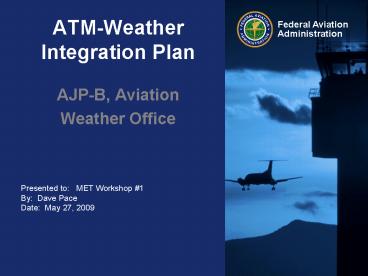ATMWeather Integration Plan - PowerPoint PPT Presentation
1 / 17
Title:
ATMWeather Integration Plan
Description:
Foundation: mature weather methodologies. Development. Test and evaluation. TRL. 10 ... post-dial down. No delay. MNT = 60 mins. ZKC_wx. Current SEVEN assigned ... – PowerPoint PPT presentation
Number of Views:31
Avg rating:3.0/5.0
Title: ATMWeather Integration Plan
1
ATM-Weather Integration Plan
- AJP-B, Aviation
- Weather Office
2
Background
- Weather accounts for 701 of all air traffic
delays within the U.S. National Airspace System
(NAS) - Total cost as much as 41B annually2
- Thus weather portion costs over 28 billion
annually - Up to two thirds of the weather delays are
avoidable3 implying benefits pool of 19B
Sources 1 OPSNET 2 Congressional Joint
Economic Committee May 2008 3 REDAC
Weather-ATM Integration Working Group Report Oct
3, 2007
3
Problem Statement
- Most weather support to ATM is manual, with
weather displays that must be interpreted by the
user - Weather products do not have the maturity
required for direct insertion without
interpretation - Rules for interpretation and use of weather data
are generally based on the experience of the user - ATM decisions based upon todays weather products
are inconsistent from user to user - This aspect of the problem is addressed in the
NextGen Weather Plan rather than in the
ATM-Weather Integration Plan
4
Working Definition
- ATM-Weather Integration
- The inclusion of weather information
- into the logic of an ATM decision process or
decision aid - such that weather impacts have already been taken
into account when the decision is made or
recommended
5
Strategy
- Bring together two communities
- Technologies and methodologies for
- Translating weather into impacts
- Dealing with uncertainty
- Capabilities under development
- Solution Sets
- JPDO Working Groups
6
Conceptual Flow of the Plan
- Decision Rules
- Examples
- Acceptable severity level
- SFO parallel approach
- From user community, with support from Appendix
B - Ownership Users, with support from weather
community - Located multi-use service unique in user systems
- Translated Impact Parameters
- Examples
- CWAM
- EDR index to aircraft type
- From Appendix B
- Ownership wx community with user guidance
- Located multi-use in network service unique in
user systems
- Decision System
- Examples
- TFMS (Traffic Flow Management System)
- TBFM (Time-Based Flow Management)
- From users, and cataloged in Appendix A
- Ownership users
- Located user systems
- State of the Atmosphere
- Examples
- Convective wx forecast
- Turbulent eddy dissipation rate (EDR)
- From weather systems
- Ownership wx community with requirements from
users - Located 4D Weather Data Cube
7
Analysis of decision capabilities done
- Over the six non-weather solution sets
- By swim lanes and then capabilities
- Initial focus on mid-term
- Have looked for points of weather impact as
injection points for weather into decisions - Details in appendix to be continuously updated
8
Analysis of weather integration methodologies done
- Have 30 for translating weather information into
impact information - Have 10 for uncertainty and ATM decisions
- Mostly medium maturity
- In execution, number to be winnowed and some
brought to high maturity
9
Execution concept
- Step process
- Analysis and team alignment
- Determine integration opportunity points
- Identify methodologies for impacts and
uncertainty - Support implementation into tools and processes
- Foundation mature weather methodologies
- Development
- Test and evaluation
- TRL
10
Example Concept SEVEN 7
Interactive Dynamic Flight List (IDFL)
- Trajectory Option Set
- (TOS)
11
Severe weather is developing as forecast, ATCSCC
reviews demand. FCA created from FEA
Green routes indicate flights crossing the FCA
Demand through the ZKC FEA at 1727z prior to
capacity dial down
12
Weather continues to develop ATCSCC conferences
stakeholders. Decision to dial down to 60
capacity
Flights with valid reroute options in their TOS
get rerouted (shown in white)
Some flights get delayed (shown in yellow)
Demand through the ZKC FEA at 1732z after
capacity dial down to 60
13
Question
- How far do you turn down the Big Dial of
SEVEN?? - Answer look to the weather translation
methodologies
14
Weather Avoidance Field (WAF)
Creating the Model
Applying the Model
Weather Avoidance Field (WAF)
Echo top
VIL
Trajectory data base Weather encounters
classified as deviations or non-deviations
Statistical pattern classifier
Deviation probability
Decision model
Deviation predictors
- WAF gives probability of deviation at each pixel
15
Throughput Estimation from WAF / CWAM
Estimate AFP Airspace Availability
AFP Throughput Estimate
Actual Weather
Predicted usage based on actual weather
- Route Blockage Model used to determine individual
route availability (RA)
80
16
ATCSCC dials down capacity impact on a
particular flight.
post-dial down
TOS for pre-dial down
RMNT Route Minimum Notification Time required by
the user to accept the given trajectory
17
Summary
- Plan provides
- Ingredients for ATM-Wx integration
- A recipe for combining them
- For execution, will still need
- Cooks to go into the DSTs kitchens
- A couple of chefs directing and coordinating
- Pots and pans (testbed, training, etc)
- See the plan at http//www.jpdo.gov/newsArticle.a
sp?id110































